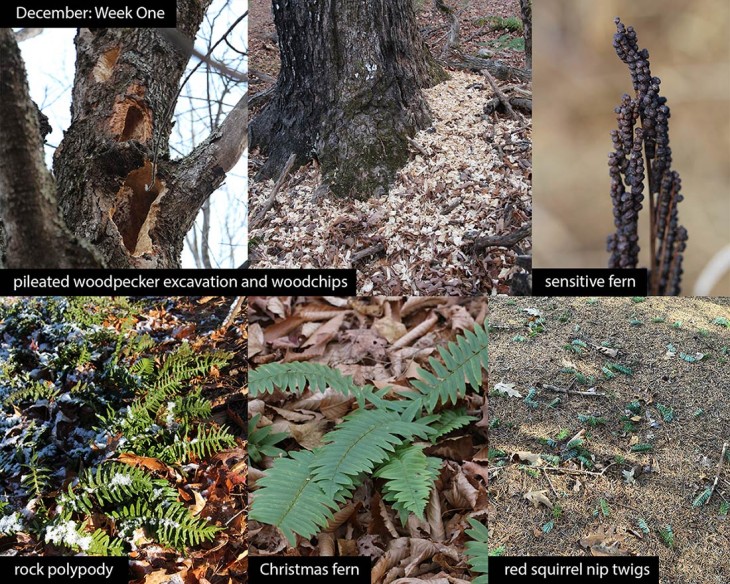This Week in the Woods, we came across a pileated woodpecker excavation, with large vertical, rectangular holes typical for this species. The blond wood and layering of woodchips over this year’s leaf litter indicate that the holes were made recently. As Meghan McCarthy McPhaul describes in this Outside Story article from 2020, pileateds prefer downed, dead, or dying deciduous trees such as this sugar maple for foraging. After they finish scraping out carpenter ants or overwintering larvae from the wood, numerous other bird and mammal species use these cavities for roosting and nesting.
The sensitive fern takes its name from the fact that its leaves succumb so quickly to first frost. Its alternative name, bead fern, derives from its fertile fronds, which hold bead-like spore capsules and brown upon reaching maturity.
Two other ferns, the rock polypody and Christmas fern, stay green throughout winter and keep their spores in round spots beneath their leaflets. Rock polypodies often grow in mats and thrive in moist, shady cliffs and sites with shallow soils. By flattening to the ground during winter, Christmas ferns stay sheltered from the wind and remain warmer than the air above them. Their leaflets sport small protrusions at the base that make them resemble miniature stockings, and Americans have long used the evergreens in decorative wreaths for their namesake holiday.
Speaking of Christmas, we spotted these branch ends underneath fir trees in what appears to be an abandoned and overgrown Christmas tree crop in West Fairlee, Vermont. Red squirrels likely clipped these tips, ate the buds or the seeds from their cones, and let the remaining short nip twigs fall to the needle bed below. Porcupines feed in a similar manner but make angular bites, and because they weigh too much to reach the ends of branches, they leave larger needled twigs, up to 2 inches around and 8 inches long. Firs (as well as spruces and hemlocks) provide important forage for red squirrels and porcupines during winter and early spring, when other sources remain scarce.
What have you noticed in the woods this week? Submit a recent photo for possible inclusion in our monthly online Reader Photo Gallery.


